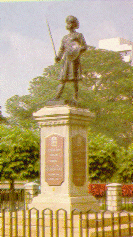Details on History of Bangalore can be found in http://en.wikipedia.org/wiki/History_of_Bangalore
Bangalore is draped over the Deccan Plateau at an altitude of 949 meters (3113 ft.) above sea level, which gives it possibly the best climate among all the cities in India
In the beginning of the 19th century, the General Post Office was opened and the Cantonment was established nine years later in 1809. In 1831, alleging misrule by Krishnaraja Wodeyar III, the British took over the administration of the Mysore Kingdom.
Under the British influence, Bangalore bloomed with modern facilities like the railways, telegraph, postal and police departments. The first train was flagged out of the city in 1859 and five years later in 1864, the lovely Cubbon Park was built by Sankey. The end of the century saw the building of Attara Kacheri and the Bangalore Palace. The 20th century saw the arrival of the first motorcar in the city.
Bangalore is draped over the Deccan Plateau at an altitude of 949 meters (3113 ft.) above sea level, which gives it possibly the best climate among all the cities in India
The present day city was designed by Kempe Gowda in the year 1537. During one of his hunting bouts, which was his favourite past time, Kempe Gowda was surprised to see a hare chase his dog and thus named the place as "gandu bhoomi" (heroic place). Kempe Gowda I, who was in charge of Yelahanka, built a mud fort in 1537 and with the help of King Achutaraya, built the little towns of Balepet, Cottonpet and Chickpet, all inside the fort. Today, these little areas serve as the major wholesale and commercial market places in the city. Kempe Gowda's son (Kempegowda the II) erected the four watch towers to mark the boundaries of Bangalore which are traceable even today and they stand almost in the heart of the present city. A hundred years later, Vijaynagar empire fell, and in 1638, it was conquered by Mohammed Adil Shah, the Sultan of Bijapur.
Pleased with the services of his trusted lieutenent Shahaji Bhonsale, (father of the great Maratha king Shivaji), Adil Shah gifted Bangalore to him. After 49 years of Maratha rule, the moghuls captured and passed it to the Wodeyars of Mysore for 3 lakh pagodas. In 1759, Bangalore came into the possession of Hyder Ali, father of Tippu Sultan. It was during these two heroes, Bangalore flourished with parks, gardens and palaces. When Tippu died, British restored Bangalore back to the Mysore rulers, the Wodeyars, but were not too sure of their entrpreuner abilities. So they ruled Bangalore directly. Under the British influence, Bangalore bloomed with modern facilities like the railways, telegraphs, postal and police departments. In 1881, the British returned the city to the Wodeyars. Diwans like Mirza Ismail, and sir Vishweshwarayya were the pioneers to help Bangalore attain its modern outlook.
|  When Tipu Sultan died in the 4th Mysore war in 1799, the British gave the kingdom, including Bangalore, to Krishnaraja Wodeyar III but the British resident stayed in Bangalore. |
In the beginning of the 19th century, the General Post Office was opened and the Cantonment was established nine years later in 1809. In 1831, alleging misrule by Krishnaraja Wodeyar III, the British took over the administration of the Mysore Kingdom.
Under the British influence, Bangalore bloomed with modern facilities like the railways, telegraph, postal and police departments. The first train was flagged out of the city in 1859 and five years later in 1864, the lovely Cubbon Park was built by Sankey. The end of the century saw the building of Attara Kacheri and the Bangalore Palace. The 20th century saw the arrival of the first motorcar in the city.
In 1881, the British returned the city to the Wodeyars. Dewans like Sir Mirza Ismail and Sir M Visveswaraya were the pioneers to help Bangalore attain its modern outlook.